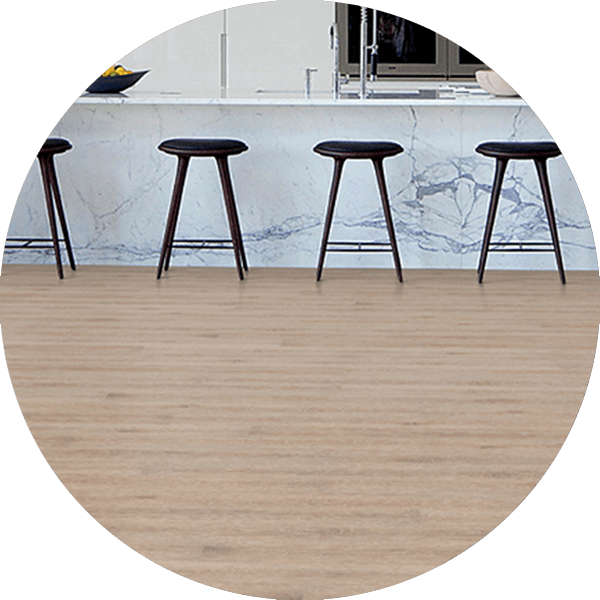

Is Vinyl Flooring a Good Choice For Kitchens?
When it comes to decorating your dining room you have several options. Dining rooms are a place for eating and drinking, for socialising and for dragging chairs in and out from the table. Your first priority is a flooring type that can resist all of this.
As vinyl flooring has become progressively more popular over the past century, we can assume it’s down to vinyl’s many benefits, such as its durability and versatility, although it does come with its own disadvantages.
While vinyl flooring brings a resistant option that’s also one of the cheapest, it does come with its own drawbacks as well. You should always weigh the pros and cons before purchasing a product that will make your home come together. We’re going to look into if vinyl flooring is the best option for your Dining room.
Last Updated: 10/02/2025
Contents
The Benefits of Vinyl Flooring
It is important to choose the right flooring for your home due to the fact that it is the first thing that people will see when they enter a room without even realising that they’re doing so; it also brings the whole room together and gives your home its visual identity to everyone who enters it.
With vinyl flooring, you can get beautiful flooring while still making it functional and affordable as well. Since vinyl is such a great option for flooring for any room, it’s a solid middle ground option that you could floor your whole house with – but that doesn’t mean that it is the best option for each individual room so let’s delve deeper.

Great Durability
When you take good care of your vinyl flooring, you can expect it to last you anywhere from ten to twenty years if you keep it in good shape and maintain it well. Due to the firmness of its top layer, the vinyl material is capable of withstand heavy foot traffic as well as resist water and light scratches.
As a result of its resistance to foot traffic and moisture, this flooring is suited for living rooms, kitchens, bathrooms, dining rooms and bedrooms. However, just because it is suitable for a certain room doesn’t mean that it is the best choice for that room. You can install vinyl flooring in these rooms and you will not have any problems whatsoever with it.
Easy To Install
When you lay vinyl, you must make sure that the ground is completely dry and fairly level before you do so. On the underside, vinyl tiles and planks have a spongy surface that can cover small ridges in flooring boards, or even some highs and lows in concrete. However, vinyl cannot mask large issues.
Vinyl is a relatively easy material to install as long as you follow a few simple steps. Typically you’ll want to lay planks or boards in the direction of the longest walls – this will elongate the room and look more attractive. If you need help though, we have expert fitters and you can even buy the vinyl from us for £10 per week with our Easipay Pay Weekly Flooring Plans.
No credit checks, no interest, just great quality flooring and low weekly payments. Tap the button at the bottom of this page to learn more.
Really Easy Maintenance
The vinyl floor is one of the simplest floors to maintain, but you should not ignore it just because it’s easy to clean. If you leave dirt and grit on the floor, you will cause scratches and damage to it. To avoid this, you can mop it with a damp cloth or vacuum it with a vacuum for dry dirt and dust that might accumulate every day.
A Huge Range In Appearances
Vinyl flooring is available in a wide variety of design options, so there’s something for everyone. Vinyl flooring has the advantage of being able to replicate wood, stone, or simply a patterned appearance, so there is going to be something for everyone if you choose this option.
It means that you will be able to get the elegant stone look or the stylish wooden look at a lower price while retaining good durability at the same time.
Water Resistance
This is what sets vinyl up for a win against laminate flooring. In rooms where there is moisture present, such as in the bathroom or laundry room, vinyl flooring is a great material to use as it is water-proof. Where laminate can swell at the joints, vinyl resists spillages even further.
The Drawbacks and Disadvantages of Vinyl Flooring
Although vinyl is an undeniable flooring material with some excellent properties, it has some disadvantages of its own as well. Among the disadvantages of vinyl, there are a few that cannot be ignored.
Resistant, But Can Still Be Damaged
Due to its inability to withstand heavy loads and the fact that it can be damaged by sharp objects, the main issue with this material is that it does not have the strength of other materials like laminate wood. You may also need to purchase new flooring in the near future as it can also be a lot more difficult to repair than other materials if damaged.
However, as long as you treat your flooring right, it shouldn’t suffer damage like this. The surface is resistant, so light scraps are fine. Just be careful dragging heavy fridge freezers across it!
Colours Can Fade
While this may sound bad, it is not as bad as you might think. The colour fade in vinyl flooring is due to direct sunlight exposure, which is why it is not recommended for outdoor or conservatory use due to extreme sunlight. In living rooms vinyl flooring should not fade unless one of your walls is entirely glass.
Not Biodegradable
Since the material is made from plastic, it does not degrade very easily even after it is disposed of. The material is also not generally recyclable although by the time your flooring is old and worn things may have changed. Disposing of vinyl flooring currently however generally means sending it to landfill if it can’t be upcycled.
In Conclusion - Which Is The Most Durable Flooring?
The three most popular options for flooring in a home are Carpets, Vinyl and Laminate flooring.
Specifically for Dining rooms you want something durable that can be wiped clean when there’s spills. You want something that can resist chair legs from being dragged back and forth. You want something that can handle foot traffic from visitors.
Carpet’s out. Spilled drinks and dropped food are a certain way to ruin a carpet, and if that doesn’t happen then the chairs being dragged around will.
This leaves vinyl flooring and laminate flooring as your two options, and frankly, both are well suited. Vinyl inches out above laminate in our books, because it’s as resistant as it needs to be in a dining room, it’ll handle all spills and drops like laminate would, but it won’t swell if you spill a drink right into the edges of the room where it’s hard to clear up.
It’s also cheaper than laminate, and you can get the same visual aesthetic from vinyl than you would with laminate. Vinyl flooring is slightly spongy underneath which makes it slightly more insulating than laminate too. It’ll be warmer on foot but the room will be warmer too as the heat from the room can’t escape through the floor quite as easily as it would with laminate. This will create a better environment for dining in.
For these reasons, we’d say Vinyl flooring is the best flooring type for Dining Rooms.
Are you on the hunt to replace your flooring? We’ve got good news!
You can replace your flooring for as little as £10 per week! We’ve had thousands of people use our Pay Weekly Flooring Plans now, and over 2500 of them have left us amazing 5 star reviews on Trustpilot!
In a nut shell, our plans let you pick whichever flooring type you’d like, such as carpet, vinyl or laminate, which we have wide ranges of options in each to choose from. With carpet and laminate, you get free underlay. With each flooring type we’ll include everything we need to fit it for free too, such as under door trims and carpet grippers.
We don’t charge interest, we don’t perform any credit checks and there’s no hidden fees. The cost of the flooring is all you pay, whether it takes you 6 days, 6 weeks or 6 months – the overall amount stays the same, and prices start from £10 per week! Fill in the form below to learn more!
About The Author
Matt
Pay Weekly Flooring From £10 Per Week!
• 0% Interest!
• No Credit Checks!
• Small Weekly Payments!
• Free Underlay!
• Free Door Trims!
• Free Carpet Grippers




